|
Monday, June 13, 2011
Progress Notes
Quite a number of visitors to our museum have been interested in the history of the old field stone building which the Miller County Historical Association in 1988 purchased from the Wright family, the last owners then of the Anchor Milling Company of Tuscumbia (photo 01).
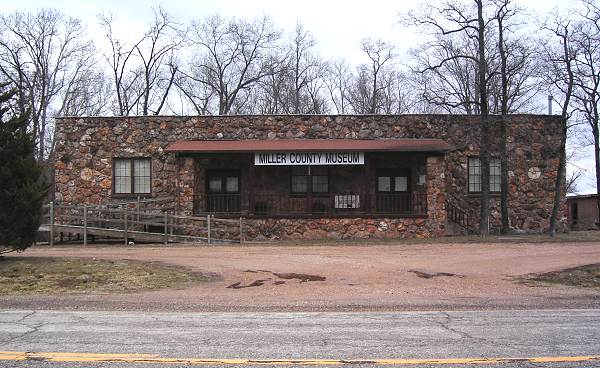
01 Anchor Mill Hardware Store now is our Museum
Also, questions are asked regarding the original water mill grinding stones embedded in the outside façade of the stone walls (photo 02).

02 Mill Stone in Wall
One question leads to another and sometimes I find myself relating the entire history of the Anchor Milling Company of Tuscumbia. This week I will present that story here. Bamber Wright is one good source of the early story of the beginning of the mill; his great grandfather, William Hauenstein Sr., was the originator of the mill. Bamber’s history of the mill, taken from our website, is presented here:
BRIEF HISTORY OF ANCHOR MILLING COMPANY
By Bamber Wright (photo 03)

03 Bamber Wright
The Anchor Milling Company dates back to 1876 when William Hauenstein, Sr. purchased a saw and grist mill near the mouth of Gum Creek above Tuscumbia (photo 04).
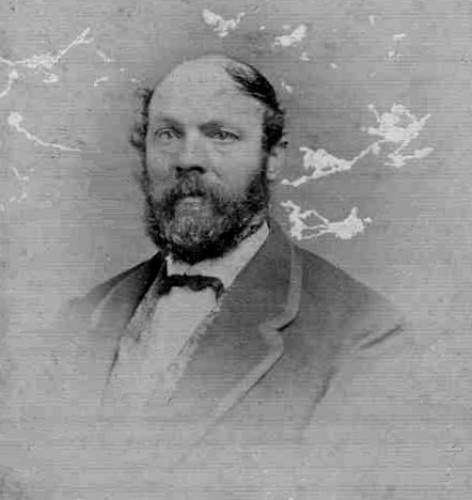
04 William Hauenstein Sr.
At that time corn was ground on 'mill stones' (photo 05).
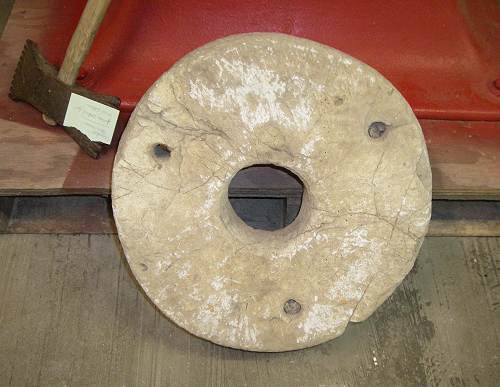
05 Old Anchor Mill Company Millstone
Our great-grandfather became aggravated at the inconvenience when his team of oxen in hot weather would stop to cool off in a pond on the way to the mill and he decided, about 1880, to move the business down the river to a location in what is now Riverside Park. About 1887, stands of steel rollers were purchased and installed. They replaced the stone burrs which required sharpening every week. After the rollers were installed, it was conceded that the mill was one of the most up-to-date in the Mid-West. Wheat flour was sold to Jefferson City and other places in a fifty mile radius (photo 06).
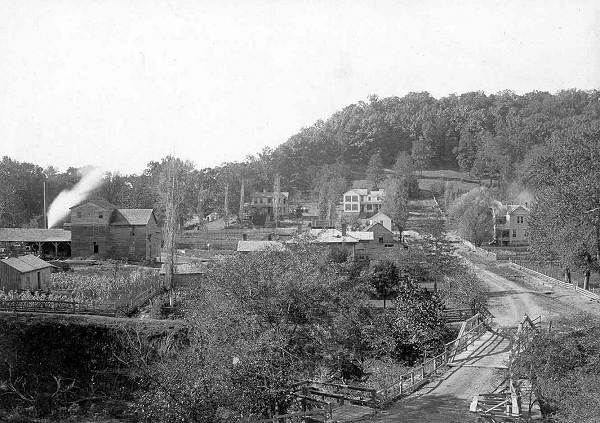
06 Anchor Mill buildings are on Far Left
The company was incorporated in 1897 and the name, Anchor Milling Company, was taken after the Anchor Steamboat Line that ran from St. Louis to New Orleans. Mr. J. R. Wells (photo 07) was the first president of the Company and in 1898, the Steamer J. R. Wells (photo 08), was launched and named in honor of the Company president. The steamer made regular trips from Tuscumbia to Osage City and from Tuscumbia to Old Linn Creek. Several trips were made to St. Louis. At the time of incorporation, the first lumberyard was established.
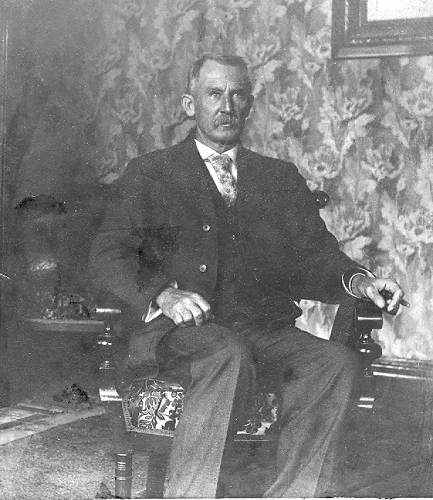
07 J.R. Wells
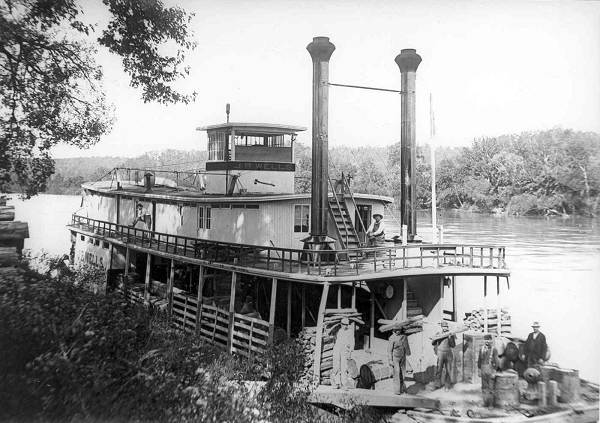
08 J.R. Wells Steamboat
In 1894, a modern flour mill was built on the river in the east end of Tuscumbia. Dozens of wagons camped at the mill for as many as 24 hours waiting to toll their wheat for flour (photo 09).
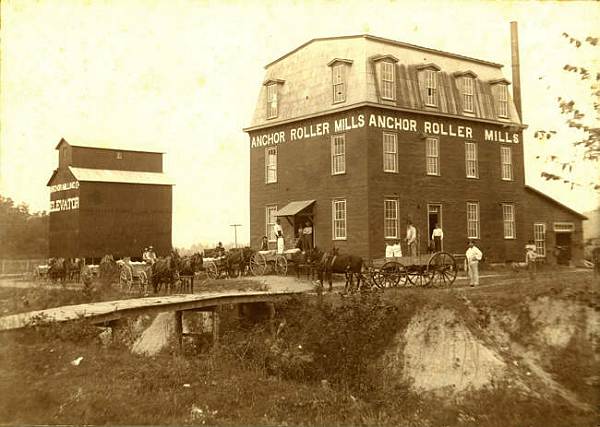
09 Anchor Mill at east end of Tuscumbia
Phillip Hauenstein (photo 10), son of William Sr. selected this site in 1894 for the new roller mills, higher than Riverside Park where the milling facilities had been located, because he thought the Osage would never reach it.
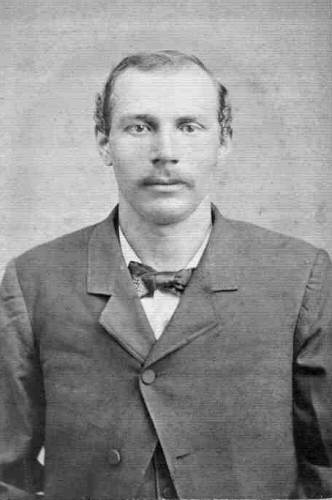
10 Phil Hauenstein
The next year the flood of 1895 came. A timber from this building showing the depth and date of that 1895 flood was used in the Anchor Milling building in Eldon where the carved record is visible in the basement.
Depth was far short, though, of that reached by the disastrous flood of 1943. The flour mill building was located downstream and across a ravine, crossed by bridge in the foreground from the hardware building and lumber shed which still stands on the river bank (photo 11).
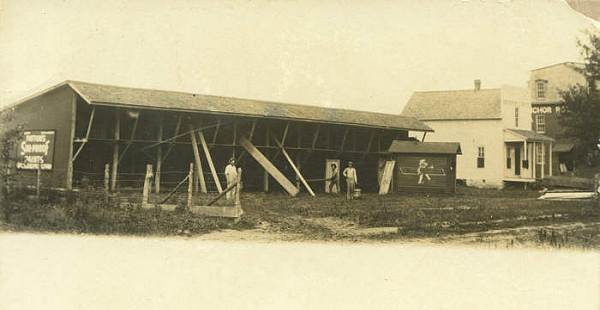
11 Anchor Milling Co. Lumber Shed, Hardware and Office by The River
In 1943 after the disastrous flood the board members decided to begin moving all operations up on the hill to escape the Osage River flood. Since Steamboats no longer were being used, the river access no longer was needed. The field stone hardware building was the first one to be built on top of the hill (photo 12).
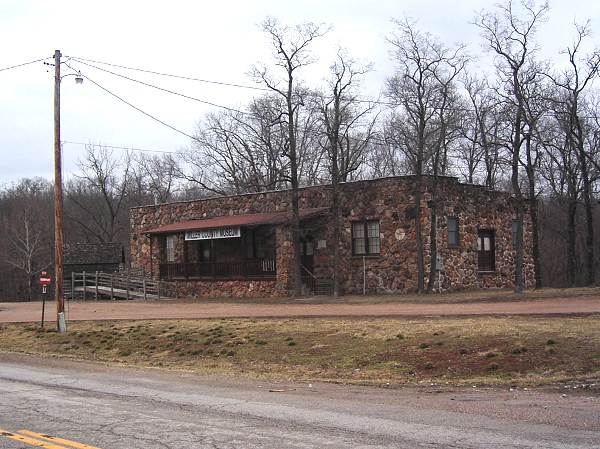
12 Original Anchor Mill Hardware Store on Hill
The flour milling business was discontinued, but the feed mill including the old roller mill was moved to the top the hill to a new building on Hwy. 52 in 1949 near the rock hardware building erected earlier (photos 13 and 14).
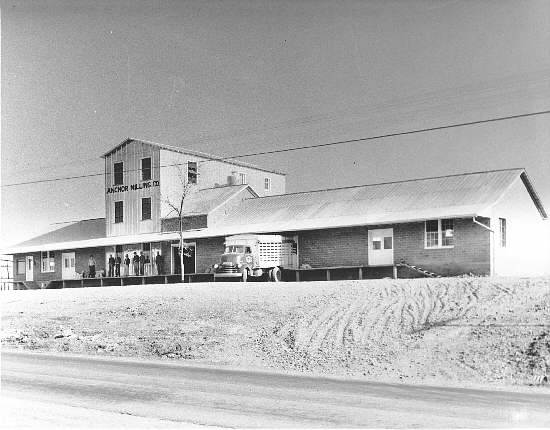
13 Anchor Mill on Highway 52 top of Hill
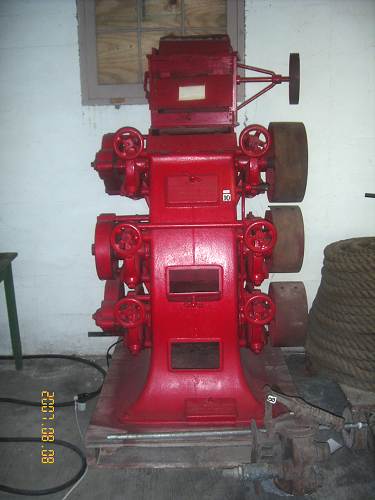
14 Roller Mill
The old roller mill building on the river bank described before, however, was continued in use for feed storage for about a half dozen more years until it was torn down. In 1960, in the mill that was built on the hill, pelleting equipment was installed along with equipment for handling bulk feed. This mill was sold in 1976.
In 1956, the Company purchased a site at Eldon at the corner of Highway 52 and 5th Street and constructed a tile building. A small milling operation was installed in the east end of the building. Jim McNeeley was the first manager of the Eldon business (photo 15).
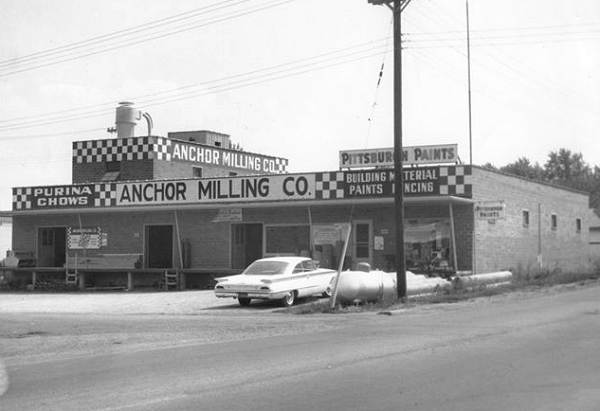
15 Anchor Mill - Eldon
C. B.Wright, father of Homer Clay Wright, was affiliated with the Company for more than 50 years, as river boat pilot, manager and as president (photo 16).
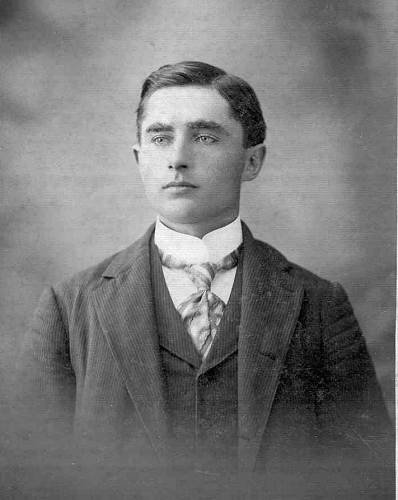
16 Clarence Boyce Wright
C.B.’s brother, Homer Lee Wright, was miller for many years and salesman (photo 17).
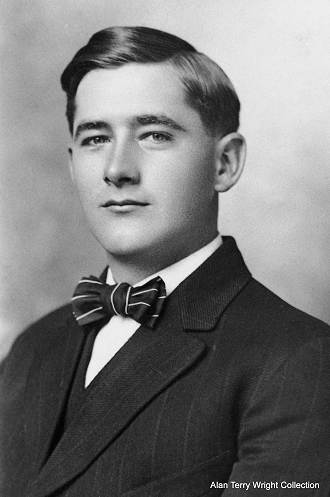
17 Homer Lee Wright
Bamber and his first cousin Homer Wright (photo 18) were fourth generation family members to be associated with Anchor Milling Co.
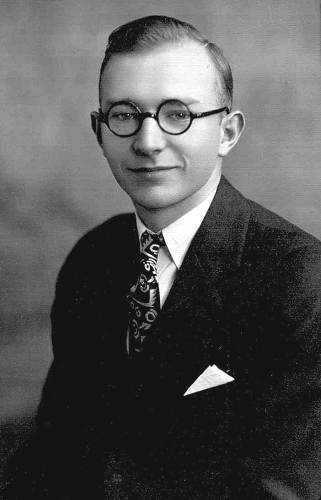
18 Homer Clay Wright
Thanks Bamber.
The Anchor Milling Company is no longer in existence. The beautiful, native rock building on Highway 52 in Tuscumbia was purchased from the Wright family by the Miller County Historical Society in 1988 and became the new home of the Miller County Museum, with a grand opening on June 2, 1991. The story about the construction of the field stone Anchor Milling Company hardware store building in which our museum now is located is interesting.
As described above, it was completed in 1943, as part of a project of the company to move all the buildings then located on the river bank up to a location on the hill to escape the frequent floods, especially one like that of 1943 which was the worst on record.
According to Bamber Wright the building was built by stone masons of the Charley McDowell family from near Kaiser. Here is a photo of Charlie McDowell working with Dewey Kallenbach to make a rock wall around the Tuscumbia Cemetery back in the 1960’s (photo 19):
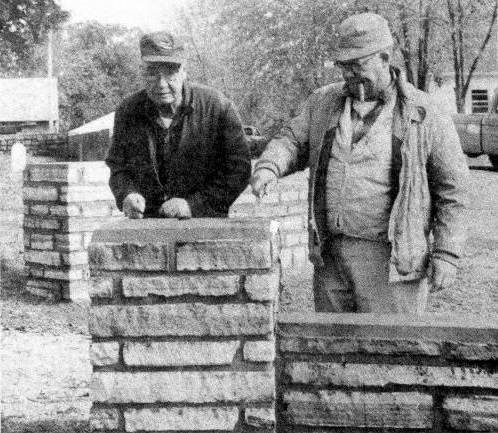
19 Dewey Kallenbach and Charles McDowell
Royal Kallenbach (photo 20), local carpenter now 92 years of age, reports that the McDowell family built many stone buildings in the Lake area as well as in the county during the early part of the last century. Royal said that the work harvesting the stones for building construction was very labor intensive because the only tools available were “bar, pick and shovel”.
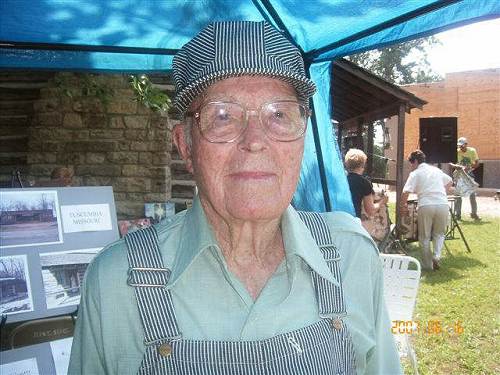
20 Royal Kallenbach
The stones usually were found on hill tops, sometimes in what was called a “bald,” an area so filled with rocks that less vegetation grew naturally. The stones were usually “soap”, (a soft sandstone), flint, lime, or regular sandstone. They were hauled out by wagon and horse to be delivered to the building site on trucks.
As mentioned above, when you come to the museum next time, look closely at the façade and you will see on each end of the building embedded in the outer stone wall two old mill stones. They were originally part of the James Lawrence Wright Mill on Saline creek which was running in the middle and late 1800’s (photo 21).
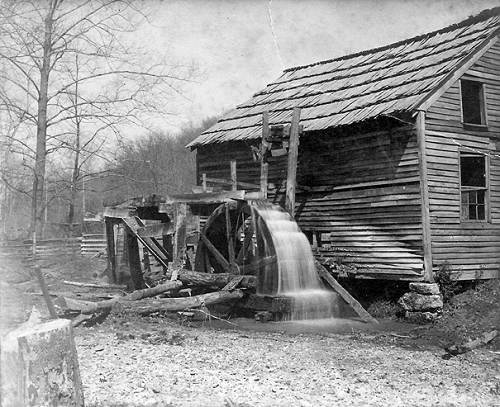
21 Wright Carding Mill on Little Saliine Creek
An interesting interview of Homer Clay Wright was published in the Autogram in 1976, the year of the nation’s bicentennial. I copied this from a clipping so I don’t have the exact date of publication:
Miller County Autogram Sentinel
1976
Judy Bowman
What a man has been “all my life” is too precious for bartering on a bicentennial or a centennial. That’s the idea one gets form talking to Homer C. Wright of Anchor Milling Company about his plans for the celebration of the company’s hundredth birthday in 1976. Wright says he’s not worried about plans for any kind of celebration. For now, sharing a few memories of the mill’s history with visitors will suit Wright just fine. The Tuscumbian’s proud heritage in Anchor Milling Company goes back to 1876 when his great grandfather, William Hauenstein, Sr. established a mill on the Osage River.
By 1894 Homer Wright’s great grandfather, William, and grandfather, Phillip Hauenstein, had established Anchor Roller Mills (see photo 04 and photo 10 above). A year later the Hauensteins had a saw mill and a grist mill in what is now Riverside Park. But the flood of 1895, “the biggest to that date,” Wright says, prompted his grandfather, who was by then in charge, to establish Anchor Milling Company on higher land a short distance down the river in 1897. The mill was the first one to have rollers for grinding wheat, instead of just stones, which were being used by most mills of the period.
Note: This roller mill is now on display in our museum. It was built in 1889 (see photo 14 above). Here is a photo of Homer with the roller mill taken from this article (photo 22):
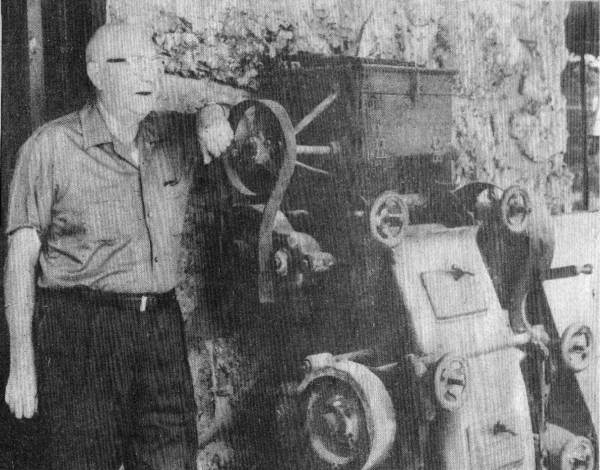
22 Homer Clay Wright with Old Roller Mil
An important part of Wright’s memories includes the use of steamboats for hauling merchandise to and from the mill. “I have the old freight records. Dad was clerk on the J.R. Wells ship, which was built in 1897. They hauled everything there was to haul” Wright says of the boats which, made regular trips from Tuscumbia to Linn Creek well supplied.
Note: Homer’s father was C.B. Wright, who eventually became president of the Anchor Milling Company (see photo 16 above). Here is a photo of the J.R. Wells steamboat on which C.B. Wright worked as a clerk (photo 23):
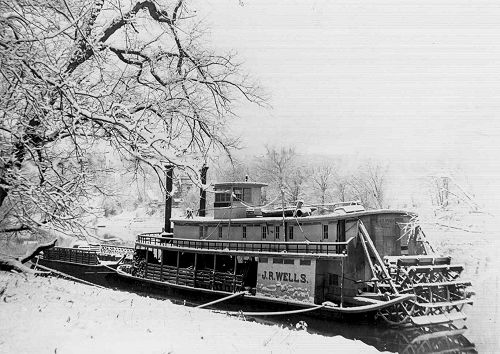
23 J.R. Wells Steamboat
Wright admits that his appreciation of the steamboats at the time when they were young and he was young is “not anything like what I should have had.” Wright would join in the Sunday excursions to Bagnell at times. Jim Walker, a cook on one of the steamboats, brings back special memories for Wright. “Jim would take me and we’d go froggin’ and fishin’.”
“I remember the later boats.” Wright says. One of the last boats to travel the Osage was the Homer C. Wright itself, named by Phillip Hauenstein as a tribute to his grandson (photo 24).
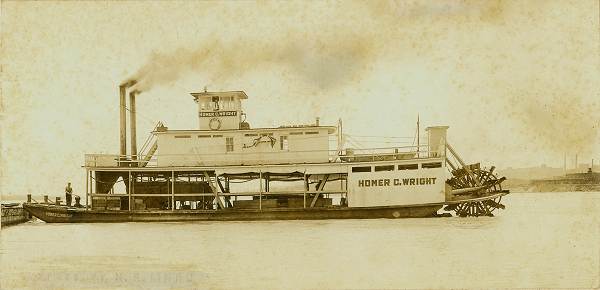
24 Homer C. Wright on Missouri River
Today, a visitor to Anchor Milling Company in Tuscumbia may view a model of the Homer C. Wright built by Wright’s distant cousin from the state of California, Fred Hauenstein (photo 25), who built the model when a 90 year old (photo 26).
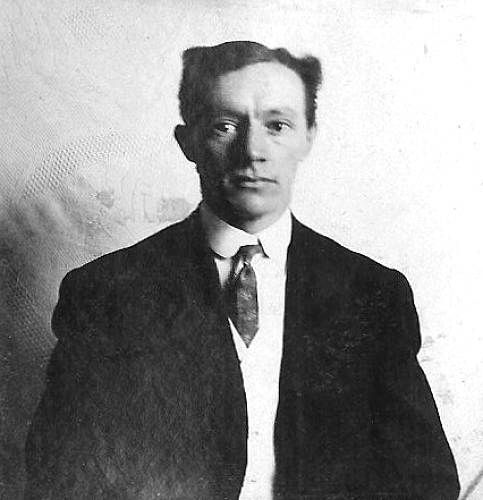
25 Fred Hauenstein
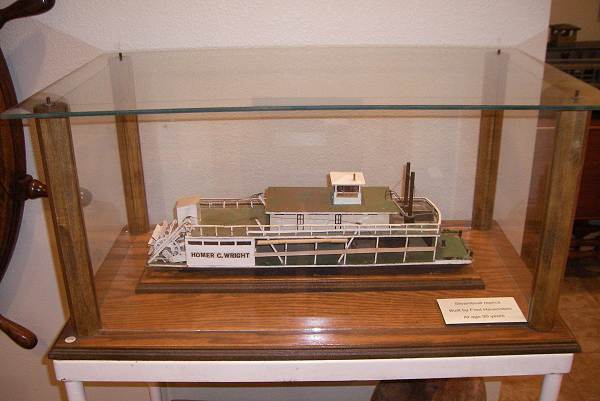
26 Homer C. Wright Steamboat replica made by Fred Hauenstein
A steamboat steering wheel of the Homer C. Wright also is on display (photo 27).
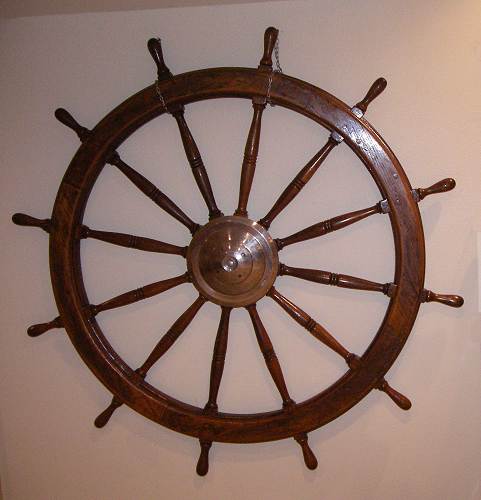
27 Wheel of Homer C. Wright
Note: The steamboat model and wheel now are on display in the lower level of the museum.
The Homer C. Wright met its fate in 1923 when it was sold to Union Electric for use as a ferry when Cahokia electric plant was built near St. Louis. “That ended boating.” Wright says. The boats had enjoyed nearly a century of popularity on the Osage.
Gerard Schultz, in his History of Miller County published in 1933, writes: “In 1889, the Anchor Roller Mills and the Steamer Frederick, owned by W.H. Hauenstein and R.M. Marshall, were the heaviest enterprises in Tuscumbia.” The Frederick was a stern wheel of 82 tons, 96 and one third feet long by 141/2 feet wide by three feet deep and was built at Tuscumbia in 1883 (photo 28).
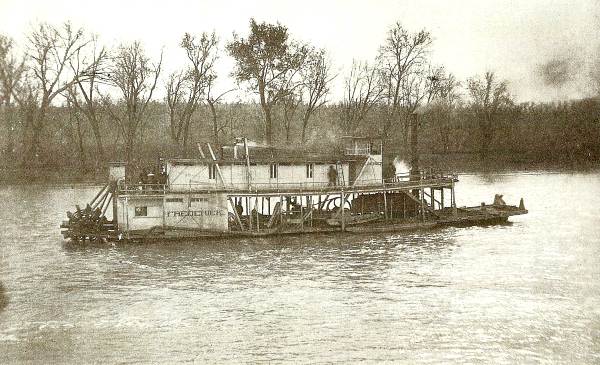
28 Frederick on the Osage
Note: The Frederick was made by William Hauenstein Jr. in honor of his only child with his first wife, Sarah Elizabeth Goodrich, who drowned after falling off a steamboat in the Osage River.
Even the present day employees at Anchor Milling Company attempt to preserve the heritage of the steamboat days. James Edwards, employed at the mill’s Tuscumbia headquarters, used his imagination to display the wheel taken from a steamboat helm. It now serves as part of a ceiling light fixture.
Note: See photo 27 above of the wheel which now is no longer part of a light fixture.
Another remnant of a rich history for the mill is a corn roller which Wright estimates to be about 80 years old. The machine was used up to 1954 (see photo 14 above).
But the visitor to the Tuscumbia mill may show some disappointment when he sees that the mill is on high and dry land, with no sign of the Osage. What Wright calls “the greatest flood” came in 1943 and “put us out of the flour milling business.” The flood also put the mill headquarters where they are today on the edge of Tuscumbia.
Besides the flood, Wright had to contend with the hardships of the war, one reason the present hardware building was constructed of native rock instead of lumber, which war time regulations made difficult to obtain. What Wright calls “the new building” of the Tuscumbia headquarters was built in 1949 and contains the roller mill and elevator.
Note: This building was located south of the stone building and was where the roller mill was used (see photo 13 above).
As the mill celebrates its centennial, Homer Wright can celebrate 50 years of full time employment with the business. His cousin Bamber, who manages the Eldon Anchor Milling Company, began full time employment at the mill in 1940. Wright admits that the Anchor Milling Company will continue to promote its rich history by distributing rain gauges and calendars with pictures of old steamboats and old mills to remind folks of the rich and long history of the Anchor Milling Company in Tuscumbia. But to capitalize any further upon a business that’s been so much more, that’s been a way of life, would not be the Homer Wright way of remembering.
Here are photos of some of the calendars sent to customers by the Anchor Milling Company (photos 29 - 36).
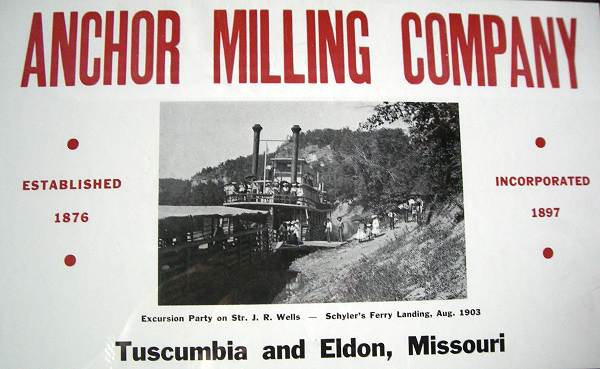
29 Excursion on J.R. Wells
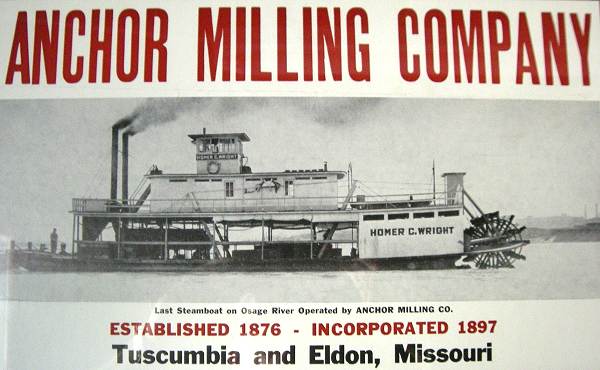
30 Homer C. Wright Steamboat
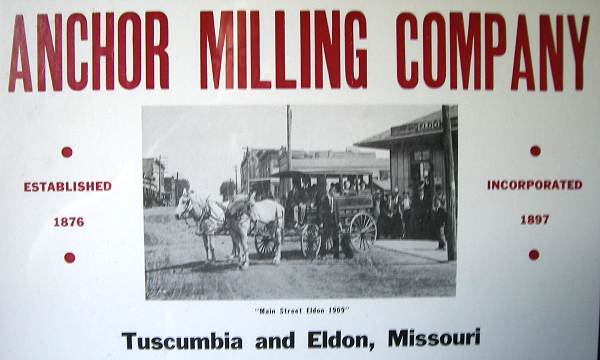
31 Main Street - Eldon - 1909
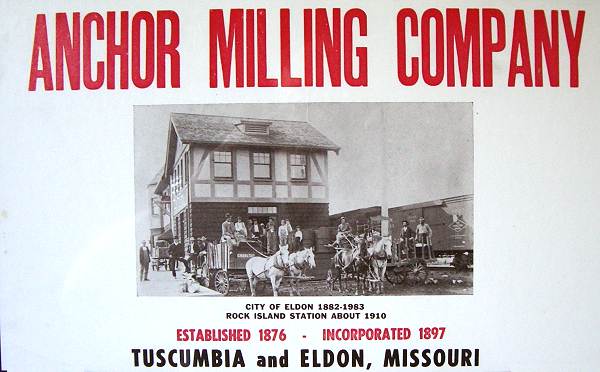
32 Rock Island Station - 1910
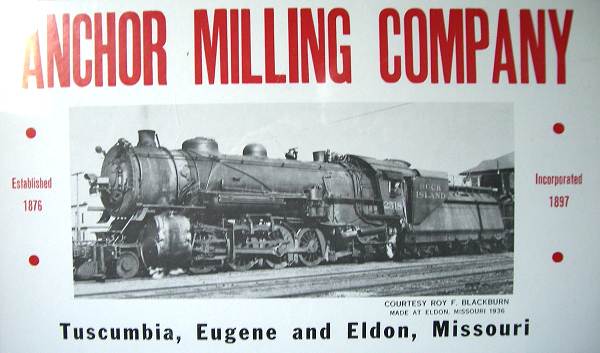
33 Rock Island Steam Engine
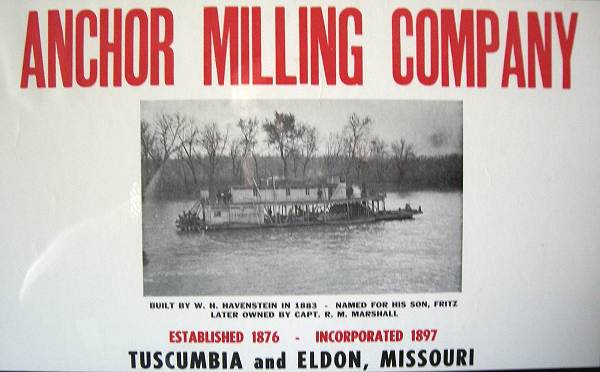
34 Steamer Frederick
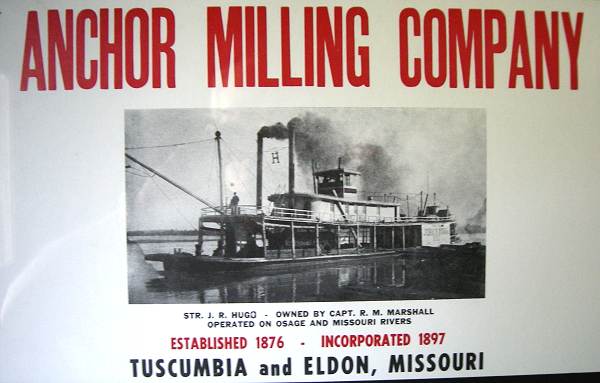
35 Steamer Hugo

36 Swinging Bridge - Tuscumbia
As time passed circumstances for Anchor Milling Company changed through the years. Steamboats in Tuscumbia began to be replaced by trains in Eldon for transportation of goods and products to the county; therefore, the Anchor Milling Company saw no need to remain located on the Osage River bank to be a victim of the recurrent floods. So the company moved up onto the hill. But after a number of years, commerce continued to be shifted to Eldon more than Tuscumbia. So an Eldon branch of the Anchor Milling Company was located in Eldon and eventually the Tuscumbia location was closed. The following article gives more information:
Clipping from either Autogram or Advertiser
1986
Closing of Anchor Mill Hardware Store
If one looks closely at Homer Clay Wright, it is easy to imagine him more than 60 years ago when, as a young boy of 12, he pestered his dad to give him a job only to quit the work when the newspaper arrived.
“He told me then, ‘If you want a job, get to it’,” Wright recalled.
And Wright, the famed J. Leg in the popular column published in this newspaper called “From the Diary of C.B. Wright,” like his father has “gotten to it” during most of his 75 years (photo 37).
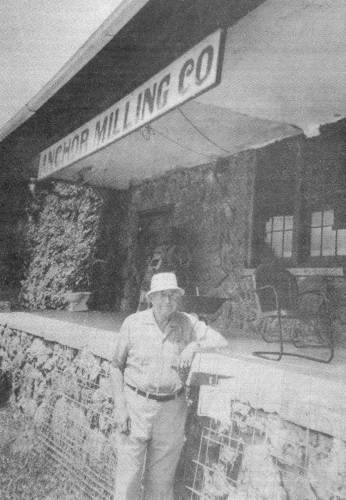
37 Homer Clay Wright - Photo from Newspaper Article
There was a stint with the United States Army where he reached the lofty status of corporal, and he did spend four years as a teacher and coach at Tuscumbia High School, but the life of Homer Clay Wright…and J. Leg for that matter…has been wrapped up in the Osage River, some boats and the thriving hardware and lumber business called Anchor Milling Company (photos 38, 39 and 40).
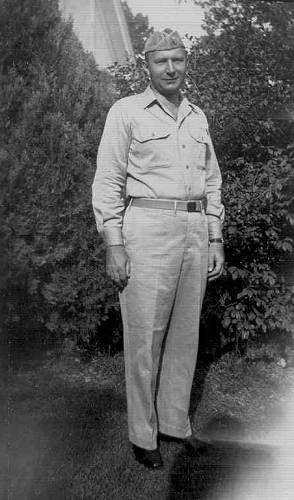
38 Homer C. Wright - WWII
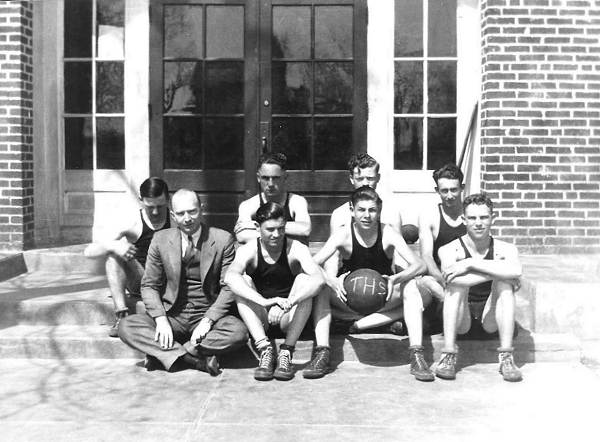
39 THS Basketball Team - 1933
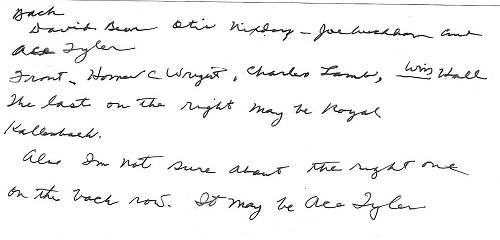
40 THS Basketball Team - 1933 Caption
Click image for larger view
When the Tuscumbia store is closed this year, as soon as its stock is depleted, it will mark the end of a long standing relationship between Anchor Milling and Tuscumbia. The two grew together until they peaked, first the town and then the business. It is no longer economically feasible for the company to keep a Tuscumbia store, and Wright has a simple explanation.
“All little towns are having trouble,” he said.
But that wasn’t always the case. Time was when Tuscumbia was a thriving town of 500 with a hotel, restaurants and an all purpose general store. In the 1920’s and 30’s, the place was bustling. It was the county seat then too, and all the office holders lived there, as did the school teachers. Today, it is a commuter’s world.
“Tuscumbia was a nice little town,” Wright said. “I can remember 25-30 outstanding men who lived here”
There may still be some outstanding men in Tuscumbia, but the general population has dropped to about half of what it once was.
Malls and discount stores have encouraged consumers to drive miles for material they once bought at home, and businesses like Anchor Milling may thrive in Eldon, but they struggle in a town like Tuscumbia.
“They (customers) used to come here and buy what they needed to build,” Wright said. “Now they run all over hell’s half acre to find a little bit better price. They think they do but they don’t.”
So the decision was made early this year that the Tuscumbia store would be closed. Archie Roark, a 35 year employee at the store, will be eligible for Social Security in July, and Wright saw no need to have to hire a replacement for a store that simply is not as well shopped as it once was (photo 41).
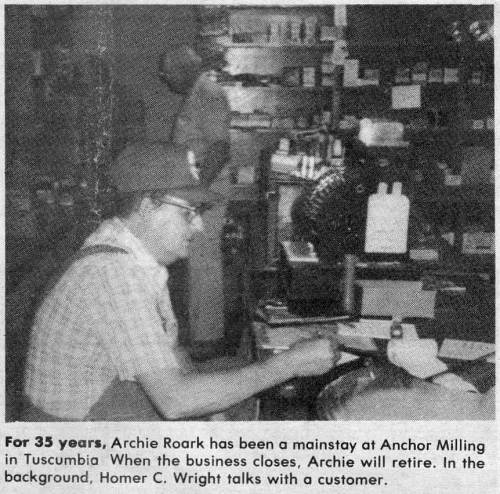
41 Archie Roark
The Eldon store will, of course, remain open, but a chapter of Miller County history is closed with the Tuscumbia store’s demise. Wright’s great grandfather, William Hauenstein Sr., opened a grist mill on the Osage River above Tuscumbia. In the late 1800’s, the business moved to what is now Riverside Park. Later, the family built a roller mill, then its first steamer, J.R. Wells.
That steamer was named after a family friend and local farmer, and many were the trips it made from Tuscumbia to Linn Creek or down the Osage to connect with the Missouri Pacific Railroad.
When the Wells was finally retired, Anchor Milling bought a gasoline operated boat called the “Ruth,” which they used for about 10 year (photo 42).
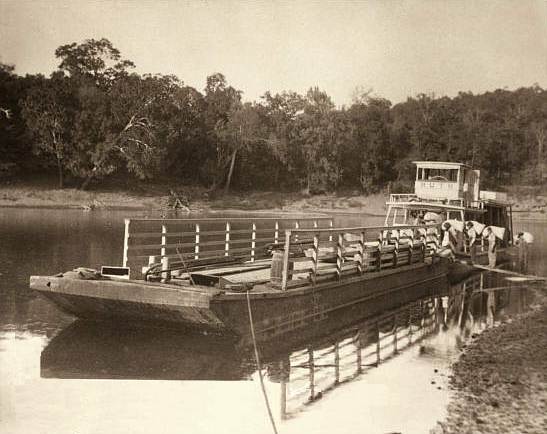
42 The Ruth with Barge
Then in 1920 the final boat to make the rounds up and down the Osage for Anchor Milling was launched. Named the “Homer C. Wright” by Phillip Hauenstein after his grandson, it lasted for three years before it was sold in 1923 to Union Electric, which used it at its Cahokia, Illinois plant (see photo 24 above).
Wright remembers the old Missouri Pacific Railroad running a train from Jefferson City down through Russellville and Eldon to the town of Bagnell.
“On court days (at the Miller County Courthouse), people would come to Bagnell by train and take our boat downriver to the courthouse,” Wright said.
But like so many modes of transportation, including the horse and train, steamboats were pushed aside by transportation alternatives.
“The roads were built better,” Wright said. “Trucks came in, and boats went out.”
Though Anchor Milling’s 25 years of river roving days ended, expansion did not. In 1924, a lumber yard was built at Eugene. It didn’t close until 1976. In 1943, after the worst flood to ever hit Tuscumbia, the present stone store in Tuscumbia on the hill was built. A feed mill was built near the store in 1949 and sold in 1976. In 1954 the Eldon store opened (see photo 15 above).
Neither Homer nor cousin Bamber Wright, another corporate officer, have any children interested in staying in the lumber and hardware business. So the future of Anchor Milling is uncertain, but plans for now include maintaining the status quo. Homer hopes to continue his travels, which have taken him to all 50 states, 20 foreign countries and five continents.
“This terrorism has slowed that down for a while,” he said.
A 1931 graduate of the University of Missouri-Columbia, Wright has been semi retired for a number of years, but with the closing of the Tuscumbia store he won’t have nearly as many opportunities to slip into work. That should please his wife Rena. He always has the weekly compilation of his father’s diary into column form to keep him busy.
That may have sounded boring to J. Leg (“I don’t know where he came up with that name, and I’ve never heard it since,” said Homer) but Homer Clay believes he can handle it.
So as often happens, time brings progress and change depending on demographics and improvements in transportation and technology. I am old enough to remember when Anchor Milling Company was a very busy and important business for Tuscumbia and much of Miller County. But technology and changes in farming and transportation of goods led to the closure of Anchor Milling Company. However, another factor was involved as well. The Company flourished so long in part because it was family owned and management passed down through three generations. The fourth generation, however, being exposed to opportunities through the experiences of college and travel made decisions to pursue careers elsewhere. After the above article was written the Eldon store was closed in 1988 and Anchor Milling Company was no more.
In our museum we have an exhibit of many things related to the Anchor Milling Company. These include photographs of the steamboats owned by the company at various times, objects having to do with steamboats as well as paraphernalia used by the mill for its business. The following photos present some of those items (photos 43 - 46):
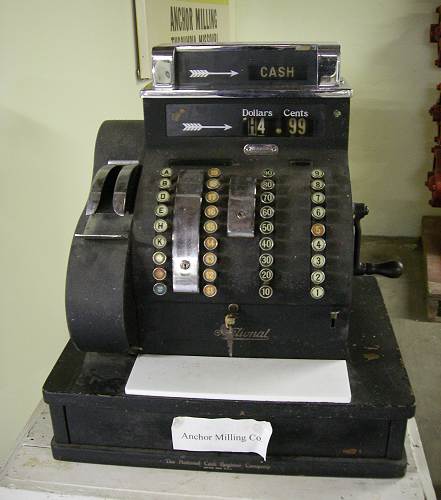
43 Anchor Mill Cash Register
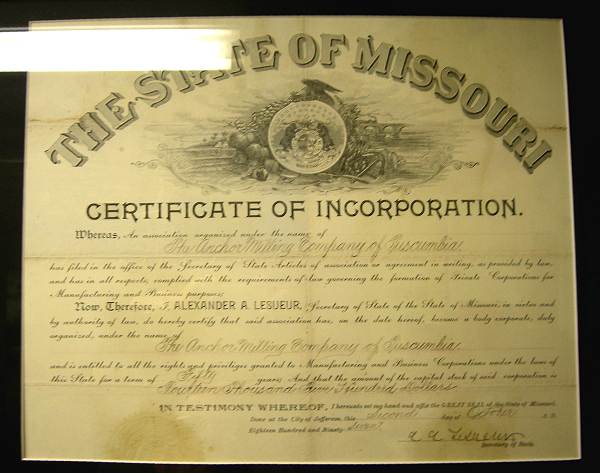
44 Anchor Mill Certificate of Incorporation
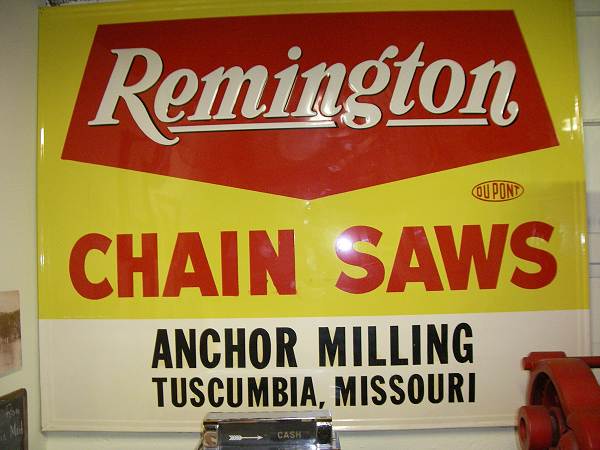
45 Old Sign
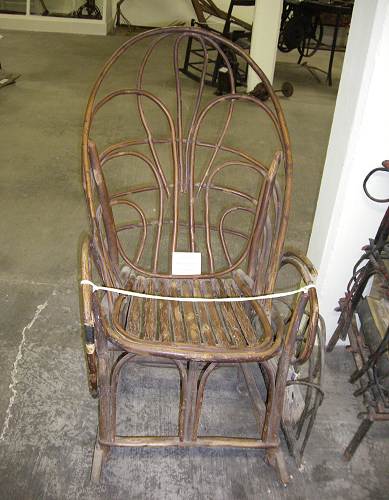
46 C.B. Wright's Rocking Chair
A pertinent accompaniment to the story of the Anchor Milling Company is the following article written in 1926 named “Steamboat Days On The Osage.” The article was published in the Autogram but no author is given. Since Lawrence Wright was publisher of the paper then I think it was he who wrote the article. It could have been historian Gerald Schultz but Gerald usually accompanied his articles with his name as author. The article uses terms for black people which now are considered pejorative and racial in nature. However, I have copied it as it was written:
Miller County Autogram
December 16, 1926
Story of Steamboat Days On The Osage River, And The Part River Navigation Took In The Development Of Miller County
This Narrative Should Have Renewed Interest Since Congress Is Instituting An Extensive Program For Reviving River Navigation, Controlling Floods And Developing The Hydro-Electric Power Possibilities Of Such Streams As The Osage
Scrambling up the river bank to an elm tree at the Tuscumbia wharf, a negro roustabout loosens the steamboat knot in a two inch line as the “nigger whistle,” with one blast gives the signal
Note: This whistle was not the large one on the boat. It was a smaller one which was used with various timing of blasts to signal orders.
The line is drawn onto the boat and coiled on the bow as the other negro roustabouts, with a “he-o,” tug at the swing stage, lift it from the bank and swing it into position. Three more blasts of the “nigger whistle” and the pilot clangs the bell in the engine room. The steamer backs from the wharf, and as she swings into position with her nose headed down stream, the big whistle sounds with a roar that was music to the old steamboat men. The steamer’s destination may be Osage City; or it may be St. Louis.
This is a dream of the past; yes, and more, it may be a vision of the future. Traffic on the Osage River since the earliest visit of the French explorers has had a leading part in the development of this section of Missouri; yes, even Oklahoma. Numerous are the points of ancient lore along this noble stream. There are scores of places where incidents transpired which would make stories in which a Mark Twain would revel with delight.
Do you remember hearing the old steamboat men talk about “Hoskins’Rock,” “King’s Bluff,” “Natural Bridge,” “Bloody Island,” “Bat Cave,” “Huricane Deck,” “Lover’s Leap,” “Big Kenslow,” “Little Ketslow,” “Round Bottom,” “Bois Bruhle,” and many other places where the experiences of the river men are replete with interesting events. “Bloody Island” and Lover’s Leap” have historical settings that would charm the poet’s pen.
Navigation on the Osage no doubt began before the advent of the white man, for when he came, Indians were using the river as a means of travel.
On the hills bordering the Osage may yet be found Indian mounds or burial places, where the bones of this race have been found in a sitting position, proving that this was the abode of the Redmen (photo 48).

48 Cairn on Osage River Hill
Then as the white man came, the Indian canoe was superseded by the flat boat.
This was back in the early part of the past century, more than a hundred years ago. Frenchmen who early explored Miller County, coming up the river in flatboats, left indelible proof of their visit by such names as the Bois Bruhle Creek, the Tavern, Gravois, Auglaize, and many other names.
As the frontiersmen pushed up the Missouri and the Osage, and settlements began to spring along the Osage in the early part of the past century, flatboats became the chief means of bringing merchandise into the country, and in taking out the products. Some of our old citizens can remember seeing some of these flatboats which were something like 100 feet in length. Sometimes six or more of these flatboats could be seen at one time at the Tuscumbia landing (photo 51).
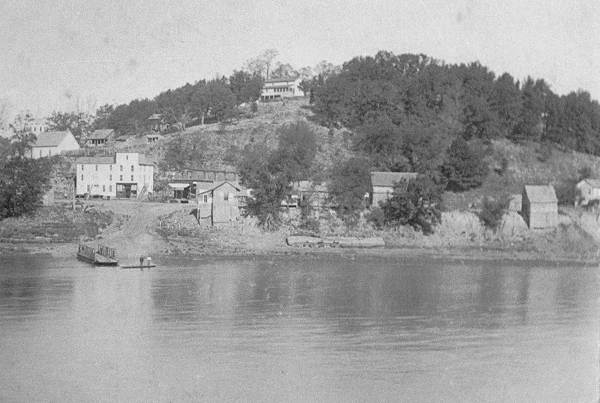
51 Tuscumbia Landing
The boats were propelled through the shoals where the water was shallow by six or eight men, an even number on either side. Standing on the bow of the boat, with faces down stream, they would thrust long poles into the water, and as they walked to the stern of the boat, it would thus be propelled through the shallow water. Each boat was equipped with a pole some 25 feet high. From the top of this pole, a rope was carried to the bank when deep water was encountered, and with this the boat was propelled to shallow water again. This method of attaching the rope to a tall tree aided in clearing the rope from the brush along the river bank. In those days, and the later days of the steamboat, Tuscumbia and Linn Creek were terminals for huge shipments of freight to the West and Southwest.
Among the early pioneers in steamboat traffic on the Osage, possibly there was no character which stood out more prominently than Governor McClurg. He was a man of small stature and he wore a long, flowing beard. His mode of dress included a “stovepipe” hat and a long tail coat. He was a pious man, and it is said that no matter how urgent the business, when midnight on Saturday came, he tied up his boat, and the line was not touched until Sunday after midnight.
His boat, “The Emma,” was employed as a government boat in the 60’s, and also at other times in doing a general freighting business. His run was from Osage City to Linn Creek, and at the latter place he built a home overlooking the Osage. This house, which is today known as “McClurg’s Mansion,” is still a point of interest at Linn Creek (photo 53).
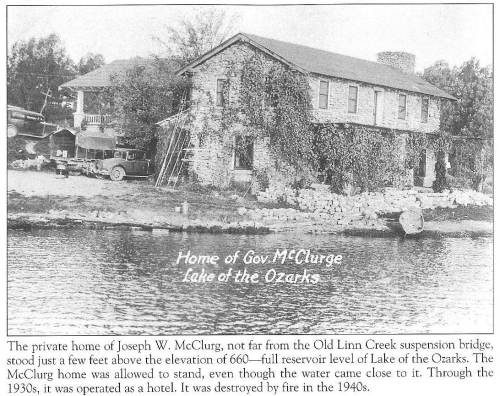
53 McClurg Mansion - Dwight Weaver
Click image for larger view
Note: After this article was written the home burned in the 1940’s.
Louis Lohmann and his father were among the early navigators of the Osage and Missouri, but their main business was on the Missouri. They operated boats between St. Louis and Yellowstone River, charging $3 per cwt., and cleaning up $75,000 in one trip.
Boats of the early day included the “Alice Gray,” “Phil Chappel,” Tom Stephens,” “Evening Star,” “General Mead,” and “Far West.”
In 1880, the “Georgie Lee,” the “Aggie,” the “W.C. Coleman,” the Plattsmouth,” the “James Watson,” the “Sport,” and the “Emma” are mentioned as being engaged in traffic on the Osage. The “Georgie Lee” was a side wheeler and drew about 16 inches of water. She was in charge of Captain Henry Baker. The names of these boats can not be forgotten once they have been heard.
Then a little later came the steamers “Hugo” (photo 54) and “Frederick” (photo 55), which, in the early days of Osage River navigation, were more closely linked with Tuscumbia than any other boats, for they were owned and operated by Tuscumbia men.
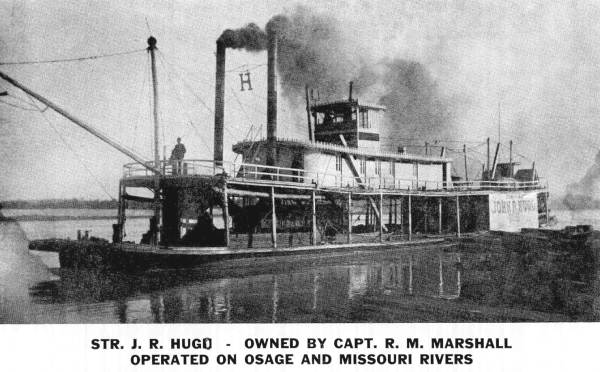
54 Hugo
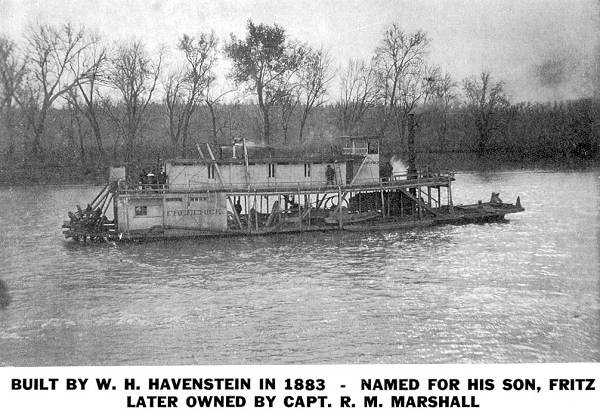
55 Frederick
Captain R.M. Marshall (photo 56) and Captain William H. Hauenstein (photo 57), both living and now residents of Tuscumbia, were two men whose names will always stand out as prominent river men of the eighties and nineties.
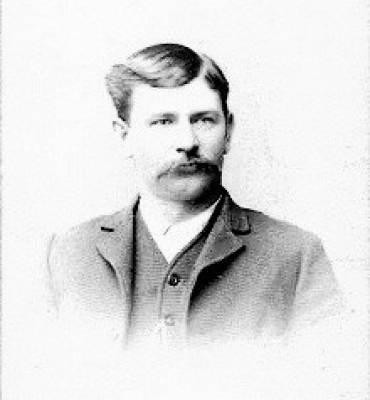
56 Bob Marshall

57 William H. Hauenstein
In fact, Captain Marshall gained prominence not only on the Osage but on the Missouri River as well. In 1888 he bought the “John R. Hugo,” which was an Ohio River boat. The boat was then 127 feet long, and as the boat needed some repairing, he lengthened the boat to 141 feet while she was on the dry dock.
Captain Marshall made a success in steamboating, his best business coming from the lower Osage in boating wheat, and on the Missouri in the government service. By aligning himself with the Missouri Pacific railroad, he acquired a heavy freighting business. This was consummated in an agreement between Captain Marshall and the railroad where by he was to deliver all his freight from the Osage to the Company at Osage City, and in return, the Railroad was to deliver all the Osage River freight to his boat. In doing so, his boat was kept busy, and the railroad secured a lot of patronage in this manner.
The railroad gave Captain Marshall the authority to make the railroad freight rate from St. Louis or Kansas City to Osage City, and the Railroad stood by his rate. Competition between railroads and steamboats was great in those days, and Captain Marshall says that the Railroad never violated its agreement with him.
He related that he once went to Kansas City after two cars of machinery. He asked the agent at Kansas City to quote a rate to Osage City, which he stated was 55 cents. Captain Marshall said this was too much, and suggested a rate of 12 ½ cents. The agent was stunned by this, and when he was told to call up the general freight agent at St. Louis, he did so, returning with the report that it was all right.
In those days there were no laws to restrict railroad freight rates, and Captain Marshall was told to use his own judgment in making the rates, but the main point was to get the business.
Steamboating in those days was a 24 hour proposition. The “Hugo” required from 15 to 20 roustabouts, and they were all Negroes. These deck hands took it for granted that they might be called upon at any time to attack a huge pile of wheat sacks on the river banks. Of course, they secured some rest between landings. (River traffic in those days did not stop for night. They were trying to take advantage of good river conditions which could change, especially with heavy rains.) On stopping along the bank to load a large pile of sacks of wheat laid there by a farmer, the Negroes would load them on their backs and return to the boat in a weaving pattern up and down the river bank usually keeping up a sing-song. One of their favorite songs was “What yo’ gwine to do when de ribber goes dry; sit on de bank an’watch de craw-dads die.”
They would sing this song for hours at a time, then change to another similar lingo.
Captain Marshall, during one season, would deliver at Osage City $5,000 worth of sacks of wheat. He also took a contract to deliver 2,000 cords of wood per year to the State Prison at Jefferson City. Another contract with the Sullivan saddle tree factory, was for delivering 1,000,000 feet of lumber from Middle River. The “Hugo” usually made a trip to Tuscumbia from Osage City once a week.
Captain Marshall worked on the Missouri River for the government six years. It seems that the government was having difficulty in towing its barges on the Missouri owing to the heavy draft of their boats. Engineers in charge of the government work sent for Mr. Marshall, and when he told them his boat could get over the shallow places, he was employed to use the “Hugo.” The “Hugo” had a capacity of 2,500 sacks of wheat and its barge, the “Jumbo,” could carry 5,000 sacks, making approximately 16,000 bushels of wheat that the boat and barge could handle at one trip.
The government agreed to pay him $40 per day, rain or shine, for the use of the “Hugo” and for his own services. The government agreed to furnish the pilot, the deck hands and the fuel. Captain Marshall began figuring, and after he calculated that he would net about $25 per day, and with the pay sure, he made a contract with the government on this basis.
Much of his work consisted of towing barges up the Missouri to St. Joe, Omaha, Council Bluffs, Nebraska City and Plattsmouth. The “Hugo” wintered at some of these places.
The Osage River had one steamer which was built exclusively for carrying the mail from Jefferson City to Tuscumbia. This boat was built by Phil Chappel, then State Treasurer, and others of Jefferson City, as a corporation. The boat was built in 1881 and was christened the “Tuscumbia.” It began carrying the mail in the spring of 1881 as an experiment. The boat was 90 feet long and 18 feet wide and had only one deck. A two foot gangway extended along the side of the cabin. The mail schedule called for the departure of the boat from Jefferson City at 6 a.m. to arrive at Tuscumbia at 6 p.m., the distance by river being about 75 miles.
In the following year (1882) the Bagnell Branch of the Missouri Pacific was built and the steamer mail was soon discontinued. The company started to build another boat for the Osage River service, but after they completed the hull, which was 130 feet long and 25 feet wide, they decided to use it as a barge, which they did in connection with the “Tuscumbia.” Messrs. Woolery & Loucks of Jefferson City were also interested in this corporation.
The steamer “Tuscumbia” will be remembered by Tuscumbia people as the boat of tragedy as it was from this boat that Mrs. William H. Hauenstein fell into the river one night while she and Mr. Hauenstein were returning from St. Louis and she was drowned. Possibly, the last time she was seen alive was by Mr. Sanning (now deceased) who was on the boat coming from Jefferson City. Mr. Sanning was an aged man and did not report seeing her fall from the boat.
The “Frederick” was a boat built by William Hauenstein Jr. in honor of his only child born to him by his deceased wife in 1882 (photo 58).
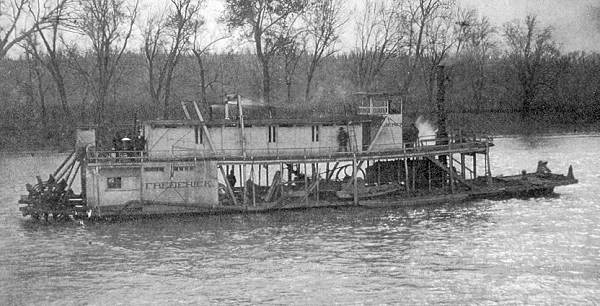
58 Frederick
In 1883, Captain Marshall bought one half interest in the “Frederick” and later he bought out Captain Hauenstein, and Captain Marshall then owned both the “Hugo” and the “Frederick.”
In 1885, the Anchor Milling Company, desiring to expand its business, began the construction of a boat at Tuscumbia to be 110 feet long and with a 20 foot beam. This boat became known as the “J.R. Wells,” so named after one of the principal stockholders of the Anchor Milling Company (photo 59).
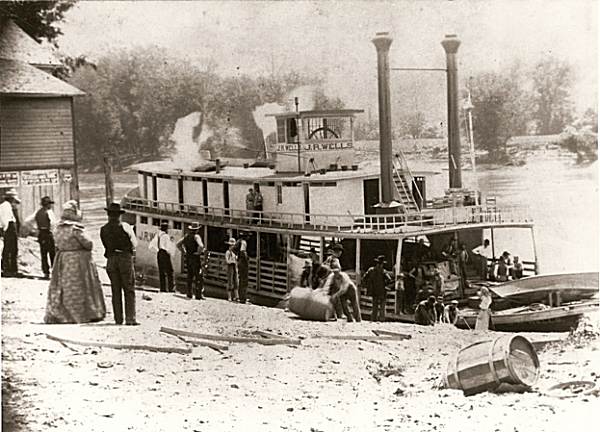
59 J.R. Wells unloading at Tuscumbia
This boat did an extensive business on the Osage with Captain John W. Adcock as pilot (photo 60).
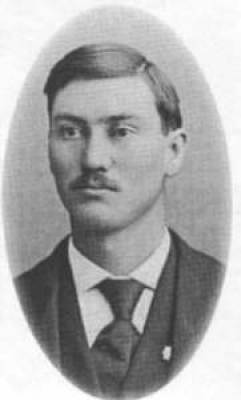
60 John W. Adcock
Later, with Captain P.J. Hauenstein (photo 61).
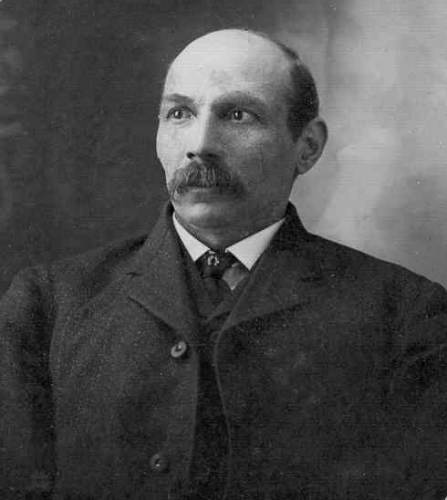
61 Phil Hauenstein
Local crews were employed on this boat, and during the boating season it was almost continuously engaged in hauling out wheat, barites, lumber, livestock, kaolin and other products as well as bringing up merchandise from Osage City and Hoecker.
The Anchor Milling Company also built a large barge, the “Ida,” which was used to advantage in the Osage River service. The “Wells” and its barge could handle approximately 6000 bushels of wheat at a trip.
The “Dauntless” was another steamboat which was built at Tuscumbia about the time the “J.R.Wells” was launched. This boat was equipped with a tubular boiler, and was about 60 or 75 feet in length. It was built by a company of Tuscumbia business men for general freighting on the Osage.
The Anchor Milling Company disposed of the “J.R. Wells” to Missouri River interests and later built the “Homer C. Wright,” which was used in hauling wheat from various points along the Osage River to the flour mill here and also to the railroad. The boat also did a general freighting business handling quite a lot of livestock (see photo 24 above).
Volumes could be written about the steamboat days on the Osage River during the 19th century. Those boats, mostly stern wheelers, but some of them side wheelers, did a valuable service during that period of time following the close of the Civil War up until the year 1910. As the railroads came into being with their methods, in early days, of cutting rates to put the steamboats out of business, the boating business soon became unprofitable. According to facts recently noted, today it costs less to ship a carload of merchandise from St. Louis to Buenos Ayres, South America, by the all water route, down the Mississippi and by steamship, than it does by rail from St. Louis to Denver; it costs less to ship a carload of merchandise to Singapore, in the Indian Ocean, half way around the world, than from St. Louis to Salt Lake City.
Army engineers are now working out a plan to make the Mississippi, Missouri and Ohio Rivers and their large tributaries navigable. If these engineers can curb the ever changing Missouri River channel, and they say they can, the Missouri and Osage Rivers may once more become a valuable means where by bulky freight may be moved at a big saving in transportation costs to the people of the great Middle West.
Lois Mace Webb (photo 62) has an interesting story of which she was reminded after reading the Progress Notes narrative about John Livingston for the week of May 16 of this year:
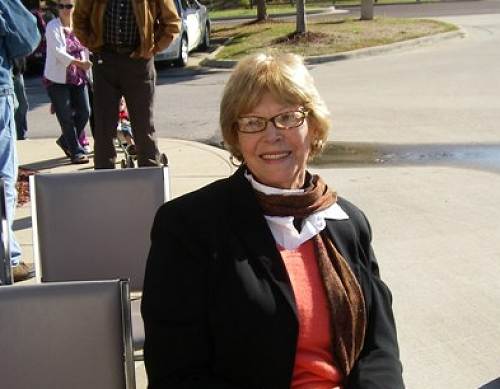
62 Lois Mace Webb
Joe,
The John Livingston history you presented recently in the May 16 Progress Notes includes Clarice Livingston Berry, Mrs. Garrett Berry, our next door neighbors in Tuscumbia and long time family friends (photos 63 and 64).
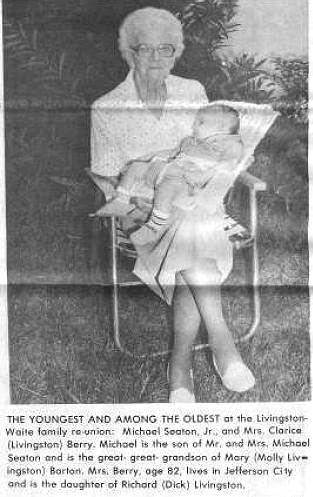
63 Clarice Livingston

64 Garett Berry
Remembering Mrs. Berry reminds me of this story, which I share with you only because it comes to mind.
In the 1940s, when my dad, Lucian Mace served as sheriff in Miller County, our closest neighbor was the Garrett Berry family (photo 65).
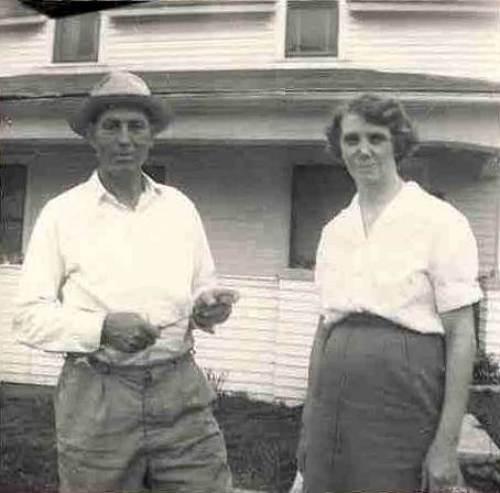
65 Lucian and Clare Mace
From our respective back doors, we could communicate with scant increase in voice volume. The ground floor of the jail building we lived in occupied the jail house; the second floor held an apartment used by sheriff and his family, including me (photo 66).
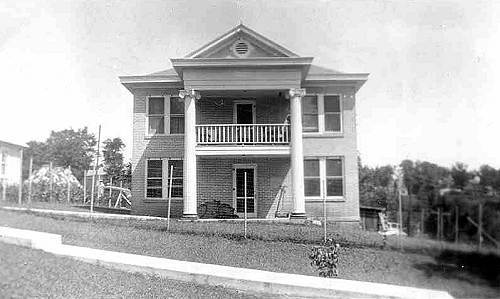
66 Miller County Jail
During that time, the Miller County jail experienced the most notorious jail break of the era. The prisoner, who faced a probable life sentence at his upcoming trial for a violent crime, evidently determined he would escape, avoid trial, and find freedom. The articulate, well groomed, physically fit man mingled with the few other prisoners in jail at the time and appeared the model prisoner. His lady-friend and her small daughter from adjoining county visited him with regularity. She often brought food, presented it for examination to my parents, who saw no reason to deny it. Her preschool-age daughter played with my preschool-age sister, Sue, on the porch and sidewalks alongside the jail.
One prisoner sentenced to jail at that time was a clean-cut looking young man, first offender for minor offence, who often was entrusted to yard freedom because my dad believed him worthy to become a trustee. My brother Lee and I loved it. He kept up the yard work, cleaned the basement, hung out or gathered in clothes from the clothes lines on laundry day -- what teenager ordinarily assigned to such chores wouldn't love it!
In the meantime, the cunning prisoner who later accomplished this daring breakout engineered his method of escape. He determined that he could, with proper tools, unbolt the frame of the structure that held the iron barred cell door. He merely needed tools. We will never know if his girlfriend brought tools baked in the cherry cobbler; nor will we definitely know if the young trustee smuggled tools from the basement. We wondered.
Our neighbor, Mrs. Berry, reported her observation to us after the fact. From the back door of her home, she could view two sides of the jail building including the basement entry and sidewalks leading to it -- the tricycle highway for the youngsters where my sister often played (photo 67).
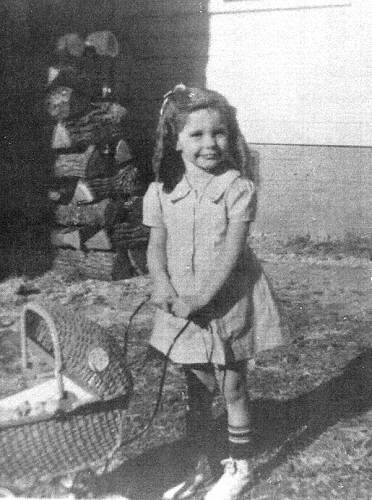
67 Sue Mace - 1940's
Next day after the jailbreak, Mrs. Berry reported to us that one day while standing at her back door, she saw Sue playing on the sidewalk; she also noticed the trustee emerge from basement door and walk around sidewalk toward jail entry. The scene, though not uncommon, caught her attention because "there was something different about the manner of the trustee." She said he seemed to walk more hurriedly, and held his arm to his side as though he carried something under his shirt. She kept her eyes on Sue, though said nothing transpired that caused her to question Sue's safety. Still, she remembered the event as "something different." My dad and mom simply kept awareness of the incident, though it yielded no definite conclusions. They remained grateful for Mrs. Berry's observation and concern for Sue's safety.
My dad discovered the escape when he took breakfast to the cell, only to find the iron barred door unbolted from its frame and leaning against the wall, the key prisoner gone, and the few other prisoners, including trustee, with scared expressions, sitting on a bench waiting for breakfast. I recall no information resulting from questioning the other prisoners, including the trustee.
The jailbreak generated the most extensive Missouri Highway Patrol manhunt the area had known at that time. Perhaps in the l930s, when small town bankrobbers flourished, manhunts were just as vigorous, yet by the 1940s, automobiles had become faster, radios had come into use, and law officers fancied their methods more sophisticated. Nearly a week after the escape, the Missouri Highway Patrol flushed the escapee out of a wooded area near Waynesville, Missouri. They found him disheveled, hungry, and wanting for rest. With gun sights aimed at him, the patrolmen demanded he strip to the skin as they approached him. The story I recall is that with patrol guns still drawn, one officer carefully examined the prisoner's belt to determine if razor blades could be spliced into the leather, validating that he was believed to be armed and dangerous.
While I do not recall details, I feel sure the prisoner found no leniency when sentencing came. I mentioned earlier that he was articulate and evidently quite clever. He is the prisoner who left a well crafted letter to my dad and mom. He thanked dad for his consideration, mom for her cooking, and the family for congeniality, including allowing sister Sue to play with the daughter of his lady-friend. He concluded the letter this way: May God bless you and your family, and may we never meet again.
The following incidents will help complete the story: My brother, Lee, about 17 at the time, worked nights and weekends at the filling station at Junction 17-52 in Tuscumbia.
Note: Here is a photo of Lee with his best friend, Judson Berry, son of Garrett and Clarice Berry (photo 68):
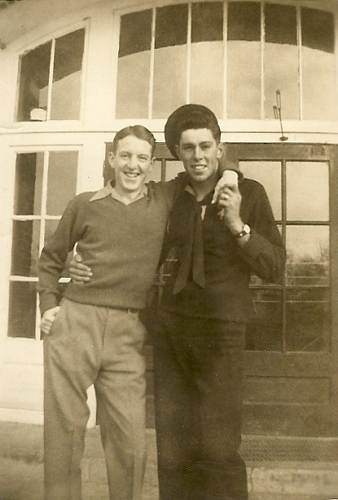
68 Judson Berry and Lee Mace in front of Tuscumbia High School
Busses on route to or from Fort Leonard Wood carried soldiers regularly and during those wartime years, government rulings made it mandatory that bus stop stations remain open to provide rest stops for the passengers. Mr. and Mrs. Wiley Berry owned the station. During the long periods between bus schedules, Mrs. Berry, an accomplished pianist, arranged for her piano to be located near the door that connected the store part of the station, to the apartment residence. So, during those hours of nil local business and waiting for the next bus, she taught Lee the basics of piano. He had learned principles of stringed instruments from our mother, and honed those skills under tutelage of three men of same family who were serving jail time because of a tire stealing charge. I might add that during wartime while tires were rationed, tire stealing commanded a fairly tough jail term -- six months in jail as I recall, for the three men. Because they came from a family of musicians, they asked my dad if their family could bring their musical instruments -- a guitar, mandolin, and fiddle. Lee and his friend, Jack Jones, locked themselves in the cell with the prisoners every chance they got and became fairly proficient in handling stringed instruments.
Note: Here is a photo of Jack Jones and his recently deceased wife, Peggy, taken many years later (photo 69):

69 Jack and Peggy Jones
The station stayed open until the 11 PM bus completed its stop; Lee got home before midnight. The stairs from the front entry of the jail vestibule led directly to Lee's bedroom directly above the jail quarters. Lee used that entrance because it attracted less notice by the family of the time he got home. In keeping with cultural custom of the time, Lee was learning to smoke cigarettes like the screen images portrayed by the likes of John Wayne, Clark Gable, Gary Cooper and others. Compounding that influence, slick magazines like Life, Look, Time, carried ads wherein doctors testified to the benefits the throat would derive from smoking cigarettes. [I'm not making that up!] So, Lee's custom as he came through the front door of the jail building after work, was to stop at the jail cell and shoot the breeze, as they called it, with the prisoners. He'd usually smoke a cigarette with them before going on upstairs to bed.
The young trustee told us later that the night of the breakout, Lee came through the front door, hesitated as if to make his usual cigarette stop, then, as if in afterthought, went on upstairs to bed, thus bypassing contact with the cell door. The trustee told us that if Lee had stopped, rested his foot on the cross piece between the bars, and leaned against the door as was his custom, that indeed the door would have fallen. The trustee said he prayed that Lee would not stop that night, and spoke of the relief he felt when Lee went on upstairs. The trustee knew the determination of the prisoner prepared to break free, and did not believe he would have spared Lee had Lee discovered the unbolted door.
Perhaps the greatest irony of the story lies in this next episode. The trustee, after having paid his debt to society, returned to the community where he lived many years as a productive member of society, married and raised a fine family. Time marches on, and Lee, after serving in the military, returned home and established a business based on music -- the Ozark Opry. One of the most talented, long standing, and productive members of the Ozark Opry team of musicians -- an adept fiddle player -- was none other than the good looking, clean-cut grown son of the trustee who served a jail term that included the time of the infamous jail break.
Unto this day, I do not know if that musician ever knew his father's history. The subject was never discussed, though at every Ozark Opry performance where he performed, and if my parents or I were in attendance, we couldn't keep from being reminded of the handsome young trustee of years gone by; the trustee who prayed that Lee would go straight to his room that night of the jailbreak.
My parents and brother and sister and I have held that and similar jail term experiences in strictest of confidence while living in the same community and often working side by side with them in various areas of service. I have always admired that quality in my family.
So be it.
Thanks Lois!
And that is the end of this week’s Progress Notes.
 Joe Pryor
Previous article links are in a dropdown menu at the top of all of the pages.
|

